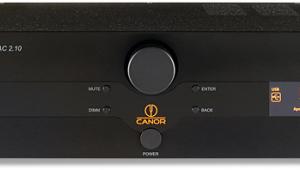Lumin D3 Network-Attached DAC Page 2
Lastly, it's perhaps worth highlighting differences between the D3 and the recently launched Audiolab 9000N, in light of Internet chat about the latter's 'it's a Lumin inside' nature. Lumin's new model is the more affordable of the two by £300-ish and includes dual DACs, the LeedH volume control and more extensive resampling. Audiolab's solution enables streaming over Wi-Fi, filter selection from its single ES9038PRO DAC, and has a colourful, customisable display. In other words, these are two very different products.
![]() Open Arms
Open Arms
Slick control and usability wouldn't count for much if the D3 delivered a performance unworthy of its price tag, but Lumin's streamer doesn't drop the ball here. With its extensive resampling/transcoding options offering scope for 'sound seasoning', particularly of 44.1kHz/48kHz media, and its DAC supporting hi-res DSD files, it throws its arms wide open to – most likely – all your music, and then gets to the heart of it through a clean, revealing performance.
Its transparency can even be a little unnerving at times as the D3 has the habit of exposing the 'flaws' in some tracks that might sound more agreeable on other systems. For example, it was hard to really enjoy Kingdom Come's Led Zeppelin pastiche 'Get It On' from their self-titled 1986 album [Polydor], because where the production aims for cavernous, epic soundstaging the D3's ruthless unearthing of its excessive reverb just made the German group sound as if they were playing an empty arena. Similarly, I've heard 'warmer' renditions of Aerosmith's 'Back In The Saddle' [Rocks; Sony Music 48kHz/24-bit] that gave its rollicking basslines a little more punch.
Most of the time, however, the D3 is a delight to listen to regardless of musical genre. 'Miss You', an eight-minute power ballad by Sunset Strip stalwarts W.A.S.P [Golgotha; Napalm Records], segues from gentle guitar and percussion in its opening verse/chorus to pounding, distorted rock capped by an astonishing Doug Blair guitar solo – the D3 flips easily between the two, sounding rich in detail and focus at the start, weighty and aggressive at the end.
'Nebraska', the title track from Bruce Springsteen's recorded-on-a-four-track 1982 set [Columbia, 192kHz/24-bit], arrived warts and all, Lumin's D3 streamer giving a fine portrayal of The Boss and his acoustic guitar, with texture to the strings and a rasp of the harmonica that bordered on strident. Tape hiss on this budget recording robs it of dynamics, but Greg Allman's solo take on his earlier band's 'Midnight Rider' [Laid Back; Island, 96kHz/24-bit] sparkled against a black background. The bass guitar sounded rich and syrupy, providing a foundation for smooth keyboard licks and Allman's well projected vocal.

There was a similar feel to the Lumin D3's delivery of Billy Joel's 'Piano Man' [Piano Man; MFSL, 88.2kHz/24-bit], where the plump bass notes and fulsome piano chords made for an inviting listen, but the clarity of his singing – and the harmonica accompaniment – ensured it sounded open and dynamic, rather than homogenous.
Coming Clean
Lumin doesn't make use of the filter options provided by the ES9028PRO DAC, but tweakers can experiment with its in-house resampling/transcoding. Downsampling (from 384kHz to 48kHz, for example) lets the D3 be used as a transport into a legacy outboard DAC. On the flip side, upsampling and format conversion bring the allure of sound quality improvements.
My listening yielded no eureka moment, although on Dire Straits' Love Over Gold [EMI], streaming over Tidal/Roon in plain vanilla 44.1kHz/16-bit, the introductory keyboard and thunder effects of 'Telegraph Road' sounded very slightly 'fuller' transcoded to DSD256. As always, mileage extracted from such user adjustment will depend on personal preference and the wider playback system, and credit is due to Lumin for making this element of its platform comprehensive and easily managed.
Moreover, even if you opt for a 'native' performance, the D3 sounds effortlessly clean, with no hash to its highs or ponder to the low-end. It isn't the last word in sheer openness and 'air', but small treble elements are always easy to discern, bringing pleasing impact to percussion in particular. On 'Industrial Disease' from the Dire Straits album, rim shots and hi-hat strikes cut through the synth background and blues guitar. And this clarity pays dividends in terms of imaging.
The recent Boston Pops Orchestra: John Williams [UME] features the film soundtrack composer waving the baton through various career highlights, plus some from others, and the D3's handling of it was largescale and thrilling. His version of Jerry Goldsmith's slow-moving Aliens theme was impressive, its undulating strings delivered with spine-tingling atmosphere, on a soundstage with plenty of width and depth.
The march from Raiders Of The Lost Ark – led by its familiar brass motif – was even better. It enjoyed genuine heft, but amidst all the drama, the D3 also reminds you of Williams' playful nature, spotlighting the track's delicate glockenspiel and flighty rhythmic feel, so you really appreciate his ability. Lumin's D3 is nothing if not insightful.
Hi-Fi News Verdict
Not for Lumin an entry-level model that's the runt of the litter, for the new D3 is closer to the company's step-up T3 DAC/streamer than the £2k price difference suggests. Wide-ranging file compatibility, extensive resampling options and bespoke app control contribute towards this unit's 'bargain' status, and the deal is sealed by its performance. Grab an audition – and take your credit card along...

























































